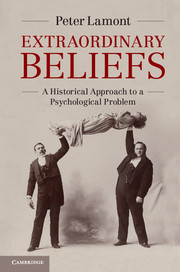Book contents
- Frontmatter
- Contents
- A brief reflexive preface
- Acknowledgements
- ONE Introduction
- TWO The making of the extraordinary
- THREE The making of mesmeric phenomena
- Four The making of spiritualist phenomena
- FIVE The making of psychic phenomena
- SIX The making of paranormal phenomena
- SEVEN The making of extraordinary beliefs
- Notes
- Bibliography
- Index
Four - The making of spiritualist phenomena
Published online by Cambridge University Press: 05 April 2013
- Frontmatter
- Contents
- A brief reflexive preface
- Acknowledgements
- ONE Introduction
- TWO The making of the extraordinary
- THREE The making of mesmeric phenomena
- Four The making of spiritualist phenomena
- FIVE The making of psychic phenomena
- SIX The making of paranormal phenomena
- SEVEN The making of extraordinary beliefs
- Notes
- Bibliography
- Index
Summary
In 1862, Charles Foster sat in a room with some very respectable ladies and gentlemen, and demonstrated what had quickly become his trademark feat. His audience wrote down different names on different slips of paper, which were then rolled into pellets so that the writing could not be seen. The paper pellets were placed on the table, so that Foster did not know which was which. Nevertheless, moments later, he began to announce, letter by letter, one of the names. He then picked up one of the pellets; it was the one with that very name written on it.
Like the lucid somnambulists of some years earlier, Foster demonstrated the ability to know what was written on folded up slips of paper. This was no demonstration of mesmerism, however, but rather a spiritualist séance, in which this extraordinary feat was seen as proof of life after death. What could easily have been seen as a demonstration of mesmerism was presented as an instance of spirit communication. The framing of such things in performance was fundamental to beliefs about spiritualism because, at the vast majority of séances, nobody actually saw a spirit. A rap was heard, a table moved, the medium conveyed certain information; all of this was taken as evidence of spirit communication, but (rather like the table movements) this did not happen by itself. What was true of Foster's feat was true of every phenomenon in which spiritualists believed: they had to be framed in demonstration, and framed in a very particular way, because spiritualist beliefs were beliefs that what happened at séances was the work of spirits. How this was done in such a way that they became the objects of spiritualist belief shall be discussed below.
- Type
- Chapter
- Information
- Extraordinary BeliefsA Historical Approach to a Psychological Problem, pp. 126 - 165Publisher: Cambridge University PressPrint publication year: 2013



